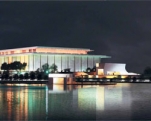John F. Kennedy Center: Global Involvment in Culture

The Kennedy Center, with the largest performing arts education initiative in the country, contains no dedicated classrooms, a limited number of rehearsal rooms, and no dedicated event space. The purpose of the proposed project is to expand the facilities of the Kennedy Center by adding spaces in a dedicated area. Additionally, the Kennedy Center envisions improving greater multimodal access to and from the Kennedy Center, NAMA, the Rock Creek Paved Recreation Trail, the Potomac River waterfront, and surrounding vicinity.
In his final State of the Union address, President Kennedy said “to further the appreciation of culture among all the people to increase respect for the creative individual, to widen participation by all the processes and fulfillments of art – this is one of the fascinating challenges of these days.” As the living memorial that bears his name, the John F. Kennedy Center for the Performing Arts fulfills this vital mission by presenting and producing the best of the performing arts, supporting the creation of new works, and providing innovative and comprehensive arts education to millions of people across the country.
As a “living memorial” for John F. Kennedy, the Center for the Performing Arts takes an active position among the great presidential monuments of the Jefferson and Lincoln memorials found within the National Mall.
The Kennedy Center, located on the banks of the Potomac River, opened to the public in September 1971. But its roots date back to 1958, when President Dwight D. Eisenhower signed bipartisan legislation creating a National Cultural Center. To honor Eisenhower’s vision for such a facility, one of the Kennedy Center’s theaters is named for him.
The National Cultural Center Act included four basic components: it authorized the Center’s construction, spelled out an artistic mandate to present a wide variety of both classical and contemporary performances, specified an educational mission for the Center, and stated that the Center was to be an independent facility, self-sustaining and privately funded. As a result of this last stipulation, a mammoth fundraising campaign began immediately following the Act’s passage into law.
President John F. Kennedy was a lifelong supporter and advocate of the arts, and frequently steered the public discourse toward what he called “our contribution to the human spirit.” Kennedy took the lead in raising funds for the new National Cultural Center, holding special White House luncheons and receptions, appointing his wife Jacqueline and Mrs. Eisenhower as honorary co-chairwomen, and in other ways placing the prestige of his office firmly behind the endeavor.
Full content of this issue you can read here
The full version of the article can be read in our printed issue, also you can subscribe to the web-version of the magazine
 Materials provided by Steven Holl Architects
Materials provided by Steven Holl Architects


